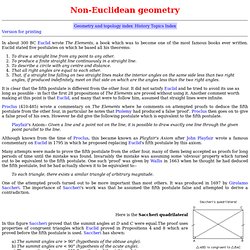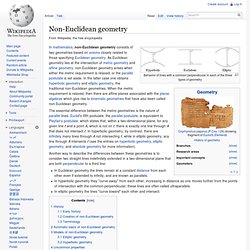Zoom
Trash

Applications Of Non-Euclidean Geometry. Non-Euclidean Geometry. In three dimensions, there are three classes of constant curvature geometries.

All are based on the first four of Euclid's postulates, but each uses its own version of the parallel postulate. The "flat" geometry of everyday intuition is called Euclidean geometry (or parabolic geometry), and the non-Euclidean geometries are called hyperbolic geometry (or Lobachevsky-Bolyai-Gauss geometry) and elliptic geometry (or Riemannian geometry). Spherical geometry is a non-Euclidean two-dimensional geometry. It was not until 1868 that Beltrami proved that non-Euclidean geometries were as logically consistent as Euclidean geometry.
Non-Euclidean geometry. Version for printing In about 300 BC Euclid wrote The Elements, a book which was to become one of the most famous books ever written.

Euclid stated five postulates on which he based all his theorems: Non-Euclidean geometry. Behavior of lines with a common perpendicular in each of the three types of geometry In mathematics, non-Euclidean geometry consists of two geometries based on axioms closely related to those specifying Euclidean geometry.

As Euclidean geometry lies at the intersection of metric geometry and affine geometry, non-Euclidean geometry arises when either the metric requirement is relaxed, or the parallel postulate is set aside. In the latter case one obtains hyperbolic geometry and elliptic geometry, the traditional non-Euclidean geometries. When the metric requirement is relaxed, then there are affine planes associated with the planar algebras which give rise to kinematic geometries that have also been called non-Euclidean geometry.